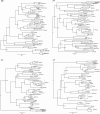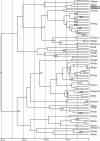Discovery and full genome characterization of two highly divergent simian immunodeficiency viruses infecting black-and-white colobus monkeys (Colobus guereza) in Kibale National Park, Uganda
- PMID: 24139306
- PMCID: PMC4016034
- DOI: 10.1186/1742-4690-10-107
Discovery and full genome characterization of two highly divergent simian immunodeficiency viruses infecting black-and-white colobus monkeys (Colobus guereza) in Kibale National Park, Uganda
Abstract
Background: African non-human primates (NHPs) are natural hosts for simian immunodeficiency viruses (SIV), the zoonotic transmission of which led to the emergence of HIV-1 and HIV-2. However, our understanding of SIV diversity and evolution is limited by incomplete taxonomic and geographic sampling of NHPs, particularly in East Africa. In this study, we screened blood specimens from nine black-and-white colobus monkeys (Colobus guereza occidentalis) from Kibale National Park, Uganda, for novel SIVs using a combination of serology and "unbiased" deep-sequencing, a method that does not rely on genetic similarity to previously characterized viruses.
Results: We identified two novel and divergent SIVs, tentatively named SIVkcol-1 and SIVkcol-2, and assembled genomes covering the entire coding region for each virus. SIVkcol-1 and SIVkcol-2 were detected in three and four animals, respectively, but with no animals co-infected. Phylogenetic analyses showed that SIVkcol-1 and SIVkcol-2 form a lineage with SIVcol, previously discovered in black-and-white colobus from Cameroon. Although SIVkcol-1 and SIVkcol-2 were isolated from the same host population in Uganda, SIVkcol-1 is more closely related to SIVcol than to SIVkcol-2. Analysis of functional motifs in the extracellular envelope glycoprotein (gp120) revealed that SIVkcol-2 is unique among primate lentiviruses in containing only 16 conserved cysteine residues instead of the usual 18 or more.
Conclusions: Our results demonstrate that the genetic diversity of SIVs infecting black-and-white colobus across equatorial Africa is greater than previously appreciated and that divergent SIVs can co-circulate in the same colobine population. We also show that the use of "unbiased" deep sequencing for the detection of SIV has great advantages over traditional serological approaches, especially for studies of unknown or poorly characterized viruses. Finally, the detection of the first SIV containing only 16 conserved cysteines in the extracellular envelope protein gp120 further expands the range of functional motifs observed among SIVs and highlights the complex evolutionary history of simian retroviruses.
Figures





Similar articles
-
Characterization of a novel simian immunodeficiency virus from guereza colobus monkeys (Colobus guereza) in Cameroon: a new lineage in the nonhuman primate lentivirus family.J Virol. 2001 Jan;75(2):857-66. doi: 10.1128/JVI.75.2.857-866.2001. J Virol. 2001. PMID: 11134299 Free PMC article.
-
Coinfection of Ugandan red colobus (Procolobus [Piliocolobus] rufomitratus tephrosceles) with novel, divergent delta-, lenti-, and spumaretroviruses.J Virol. 2009 Nov;83(21):11318-29. doi: 10.1128/JVI.02616-08. Epub 2009 Aug 19. J Virol. 2009. PMID: 19692478 Free PMC article.
-
Discovery and full genome characterization of a new SIV lineage infecting red-tailed guenons (Cercopithecus ascanius schmidti) in Kibale National Park, Uganda.Retrovirology. 2014 Jul 4;11:55. doi: 10.1186/1742-4690-11-55. Retrovirology. 2014. PMID: 24996566 Free PMC article.
-
The history of SIVS and AIDS: epidemiology, phylogeny and biology of isolates from naturally SIV infected non-human primates (NHP) in Africa.Front Biosci. 2004 Jan 1;9:225-54. doi: 10.2741/1154. Front Biosci. 2004. PMID: 14766362 Review.
-
Phylogeny and natural history of the primate lentiviruses, SIV and HIV.Curr Opin Genet Dev. 1995 Dec;5(6):798-806. doi: 10.1016/0959-437x(95)80014-v. Curr Opin Genet Dev. 1995. PMID: 8745080 Review.
Cited by
-
CD4 receptor diversity represents an ancient protection mechanism against primate lentiviruses.Proc Natl Acad Sci U S A. 2021 Mar 30;118(13):e2025914118. doi: 10.1073/pnas.2025914118. Proc Natl Acad Sci U S A. 2021. PMID: 33771926 Free PMC article.
-
Subclinical Infection of Macaques and Baboons with A Baboon Simarterivirus.Viruses. 2018 Dec 10;10(12):701. doi: 10.3390/v10120701. Viruses. 2018. PMID: 30544677 Free PMC article.
-
Zika viruses of African and Asian lineages cause fetal harm in a mouse model of vertical transmission.PLoS Negl Trop Dis. 2019 Apr 17;13(4):e0007343. doi: 10.1371/journal.pntd.0007343. eCollection 2019 Apr. PLoS Negl Trop Dis. 2019. PMID: 30995223 Free PMC article.
-
Arteriviruses, Pegiviruses, and Lentiviruses Are Common among Wild African Monkeys.J Virol. 2016 Jul 11;90(15):6724-6737. doi: 10.1128/JVI.00573-16. Print 2016 Aug 1. J Virol. 2016. PMID: 27170760 Free PMC article.
-
Seroprevalence of Zika Virus in Wild African Green Monkeys and Baboons.mSphere. 2017 Mar 8;2(2):e00392-16. doi: 10.1128/mSphere.00392-16. eCollection 2017 Mar-Apr. mSphere. 2017. PMID: 28289727 Free PMC article.
References
Publication types
MeSH terms
Substances
Associated data
- Actions
- Actions
- Actions
- Actions
- Actions
- Actions
- Actions
Grants and funding
LinkOut - more resources
Full Text Sources
Other Literature Sources

